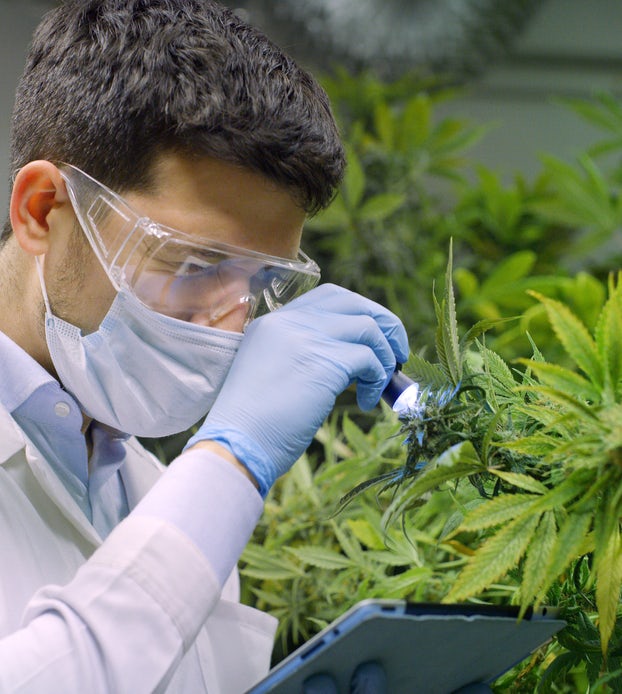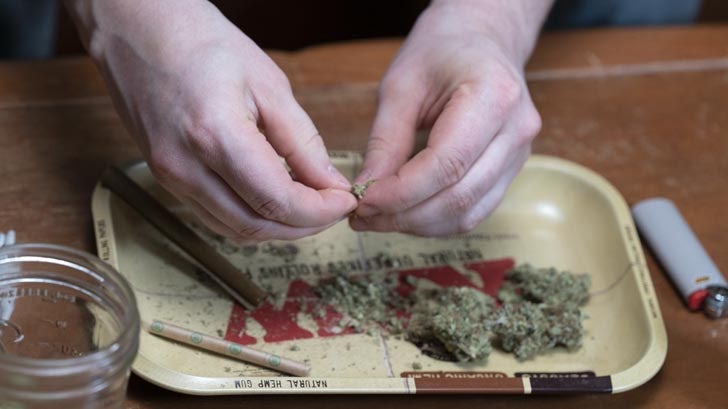Cannabis and magic mushrooms are a pair with a long lasting connection. Commonly taken together, and possessing some similar qualities, these two seem like a natural pairing. But what are the impacts from combining these two substances, and why is the combination so popular?
What are magic mushrooms?
Magic mushrooms, or shrooms, is a generic term for a variety of mushrooms that contain psilocybin, a naturally occurring psychedelic molecule. Similar to other “classic” psychedelics (like LSD, ayahuasca, or peyote) magic mushrooms can seriously alter your experience of reality, cause depersonalization, and can even induce powerful mystical experiences. While generally considered safe, eating these mushrooms results in a variety of psychedelic effects, which can vary widely from euphoria to paranoia to depending on dosing, and the context it was taken in. 1
How do magic mushrooms work differently from cannabis?
Magic mushrooms differ from cannabis in the intensity of the psychoactive effects that they bring. Unlike cannabis, which rarely produces hallucinations in healthy subjects, mushrooms, especially when taken at a high dose, tend to produce big changes in how you perceive the world around you. 2
Usually cannabis impacts cognition, emotion and perception – but it is rare for cannabis to produce true hallucinations. Cannabis alone usually only produces hallucinogenic effects in very particular contexts. Those with a family history or personal diagnosis of psychosis are particularly at risk for this effect. It is also sometimes experienced when cannabis is isolated to its most common psychoactive chemical, THC, or when ingested as an edible in high doses. Still, in rare cases, hallucinations have occurred from cannabis use alone in otherwise healthy individuals. 3
This is because the psilocybin in magic mushrooms acts like all classic psychedelics, stimulating the 5HT2A receptor. This leads to classical psychedelic effects like seeing visual patterns and an altered perception of time and space. Cannabis, on the other hand, works by stimulating the receptors of the endocannabinoid system, which is closely connected to serotonin (5-HT) signaling. 4 5 6
Are weed and shrooms similar in their effects?
While cannabis and shrooms are different in how they work, and affect people, they do have some similarities. While shrooms certainly outperform cannabis when it comes to hallucinogenic effects, both have effects that are complex, psychoactive, and powerful. Both substances can induce positive moods, impact cognition and coordination, bring on an altered sense of time and reality, and produce some of the same unwanted side effects like increased heart rate,anxiety, or paranoia.
How cannabis affects you
Cannabis can cause a wide variety of effects. Some of these effects are sought after, or even medicinally beneficial, such as:
- Elevated mood
- Nausea relief
- Pain relief
- Relaxation
- Changes in sleep and energy levels
- Reduced spasticity
Cannabis is also taken recreationally for its mind-altering, time-slowing, and relaxing psychedelic-like effects. While research is limited, anecdotal reports suggest that high doses of edible cannabis products can especially induce psychedelic-like spiritual/mystical experiences.
Unfortunately, cannabis can also cause temporary common side effects, such as:
- Dizziness
- Dry mouth
- Fatigue
- Impaired cognitive function
- Impaired coordination
- Increased appetite
- Paranoia/anxiety
- Nausea
- Red eyes
- Short-term memory deficits
Still, there are ways to mitigate many of these common side effects.
Less commonly, cannabis can lead to more serious and potentially long term side effects, such as:
- Addiction
- Cannabinoid Hyperemesis Syndrome
- Psychosis
How shrooms affect you
Similar to other “classic” psychedelics (like LSD, ayahuasca, and peyote) shrooms can seriously alter your experience of both your inner and outer world . These changes can include perceptual hallucinations, intense mental imagery, intensified emotions, and altered cognition. These classic psychedelics can also produce profound mystical experiences, creating feelings of unity, sacredness, and transcendence of space and time, along with deeply felt positive emotional states. 7 8
In the scientific literature, these psychedelic effects include:
- Altered sense of time and space
- Audiovisual synesthesia
- Changes to normal cognition
- Derealization
- Depersonalization
- Emotional empathy
- Enhanced introspection
- Enhanced sociality
- Feelings of bliss
- Feelings of boundlessness
- Hallucinations
- Increased access to emotions
- Intensification of feelings
- Mental imagery
- Mystical experiences
- Perceptual intensification
- Relaxation
- Trust
Unfortunately, some also report unwanted side effects9, such as:
- Anxiety/fear
- Auditory hallucinations
- Depressed mood
- Diarrhea
- Dilated pupils
- Dizziness
- Delusions
- Hallucinations
- Increased heart rate
- Impaired coordination
- Nausea
- Psychosis-like states
- Restlessness
- Visual disturbances
- Vomiting
These effects and side effects, while common, vary greatly between individuals. They also vary depending on the type of mushroom, dose, and context it was taken in.

Combining shrooms and weed
While both cannabis and magic mushrooms can be taken on their own, many chose to use these two substances together. In fact, a 2006 study specifically investigated polysubstance use among university students and found that nearly 60% of those surveyed co-used cannabis and shrooms. For some, this may be because of how cannabis can mitigate common negative side effects of shrooms, such as nausea and vomiting, or for others it may be a way to enhance the high of the shrooms. Notably, researchers also found that 65% also used tobacco along with mushrooms, and about 40% co-used alcohol with their mushrooms. 10
Is combining cannabis and shrooms safe?
Studies find that mushrooms alone are a relatively safe drug. A 2007 study found the use of magic mushrooms is relatively safe and only a few, relatively mild adverse effects have been reported. The 2017 Global Drug Survey found that psilocybin sent the least people to the emergency room of any drug on the market. THC is also considered a relatively safe drug, without any known potential for deadly overdose. Unfortunately, very little research exists on using these substances together. 11
While we don’t have much research on their combination, some researchers point out that we’d likely be seeing case studies with bad outcomes pop up if this was a particularly dangerous combination.
However, there is one case study where cannabis and shrooms were used that led to dangerous outcomes. But in this case, the person was also on anticholinergic and GABAergic drugs. This combination of all four medicines caused the person to be admitted to the ICU for 2 days. While it may be relatively safe to use cannabis and shrooms together, combining it with other medications can be extremely risky. 12
How will combining them alter the experience?
Using cannabis along with shrooms can alter the experience by intensifying the psychedelic effects of the psychedelics. And this effect was found to be more pronounced with larger doses of cannabis. They said that adding cannabis produced more intense mystical-type, ego dissolution and visual experiences. More cannabis means more intense experiences – which makes sense when you consider that psychedelics increase serotonin and cannabis helps serotonin from being cleared by the enzymes that would normally do that job.
Cannabis is also associated, in the scientific literature, with easing how challenging the shrooms experience is. Interestingly, it is also associated with making the shroom trip more challenging, depending on the dose. In one study, those using low and medium doses of cannabis had less negative, challenging experiences, (such as thoughts of fear, grief, death, paranoia, physical distress, isolation and insanity) than control groups using shrooms alone. But those using high doses of cannabis had more challenging experiences. 13
In some rare cases, consuming cannabis and shrooms together may also lead to developing ‘flashbacks’ of hallucinogenic effects when using cannabis later. As one case study describes, this means that after using both together, the hallucinogenic experiences associated with shrooms can come back at a later time when cannabis alone is consumed. 14
How to combine shrooms and weed safely
There is very little research on how to best combine cannabis and shrooms. But anecdotally, people vary in how they use these together. Some use before and throughout the process to ease the experience, reduce nausea. Others try to time their high to enhance psychedelic effects and deepen the intensity of the experience. Others say it’s best to use only as you are coming down from the shroom trip, to extend the enjoyable effects or to ground after the psychedelic experience. It should also be noted that some purists would say you should not mix the two in order to get the most out of the mushroom experience.
Still, since we do know that higher doses of cannabis can make your shroom journey more challenging, it’s best to keep your dosing low or moderate. And since we also know there are risks for mixing shrooms and weed with other medications, be very cautious and consult with a doctor if you are using any other medications.
Sources
- Lowe H, Toyang N, Steele B, et al. The Therapeutic Potential of Psilocybin. Molecules. 2021;26(10):2948. Published 2021 May 15. doi:10.3390/molecules26102948
- Hirschfeld T, Schmidt TT. Dose-response relationships of psilocybin-induced subjective experiences in humans. J Psychopharmacol. 2021;35(4):384-397. doi:10.1177/0269881121992676
- Barrett FS, Schlienz NJ, Lembeck N, Waqas M, Vandrey R. “Hallucinations” Following Acute Cannabis Dosing: A Case Report and Comparison to Other Hallucinogenic Drugs. Cannabis Cannabinoid Res. 2018;3(1):85-93. Published 2018 Mar 1. doi:10.1089/can.2017.0052
- Hosanagar, A., Cusimano, J., & Radhakrishnan, R. (2021). Therapeutic Potential of Psychedelics in the Treatment of Psychiatric Disorders, Part 1: Psychopharmacology and Neurobiological Effects. The Journal of clinical psychiatry, 82(2), 20ac13786. https://doi.org/10.4088/JCP.20ac13786
- Hosanagar A, Cusimano J, Radhakrishnan R. Therapeutic potential of psychedelics in the treatment of psychiatric disorders, part 1: psychopharmacology and neurobiological effects. J Clin Psychiatry. 2021;82(2):20ac13786.
- Peters, K. Z., Cheer, J. F., & Tonini, R. (2021). Modulating the neuromodulators: dopamine, serotonin, and the endocannabinoid system. Trends in Neurosciences, 44(6), 464-477.
- Kuc, J., Kettner, H., Rosas, F. et al. Psychedelic experience dose-dependently modulated by cannabis: results of a prospective online survey. Psychopharmacology (2021). https://doi.org/10.1007/s00213-021-05999-1
- Ziff S, Stern B, Lewis G, Majeed M, Gorantla VR. Analysis of Psilocybin-Assisted Therapy in Medicine: A Narrative Review. Cureus. 2022;14(2):e21944. Published 2022 Feb 5. doi:10.7759/cureus.21944
- Feng, L. Y., Battulga, A., Han, E., Chung, H., & Li, J. H. (2017). New psychoactive substances of natural origin: A brief review. Journal of food and drug analysis, 25(3), 461–471. https://doi.org/10.1016/j.jfda.2017.04.001
- Barrett, S. P., Darredeau, C., & Pihl, R. O. (2006). Patterns of simultaneous polysubstance use in drug using university students. Human psychopharmacology, 21(4), 255–263. https://doi.org/10.1002/hup.766
- van Amsterdam, J., Opperhuizen, A., & van den Brink, W. (2011). Harm potential of magic mushroom use: a review. Regulatory toxicology and pharmacology : RTP, 59(3), 423–429. https://doi.org/10.1016/j.yrtph.2011.01.006
- Aleman, Jacomien & Crul, M. & Voort, Peter & Franssen, Eric. (2012). Anticholinergic toxicity after the ingestion of serotonergic ‘magic mushrooms’. Netherlands Journal of Critical Care. 16. 93-96.
- Kuc, J., Kettner, H., Rosas, F., Erritzoe, D., Haijen, E., Kaelen, M., Nutt, D., & Carhart-Harris, R. L. (2021). Psychedelic experience dose-dependently modulated by cannabis: results of a prospective online survey. Psychopharmacology, 10.1007/s00213-021-05999-1. Advance online publication. https://doi.org/10.1007/s00213-021-05999-1
- Skryabin, V. Y., Vinnikova, M., Nenastieva, A., & Alekseyuk, V. (2018). Hallucinogen persisting perception disorder: A literature review and three case reports. Journal of addictive diseases, 37(3-4), 268–278. https://doi.org/10.1080/10550887.2019.1673655
Sign up for bi-weekly updates, packed full of cannabis education, recipes, and tips. Your inbox will love it.

 Shop
Shop Support
Support


















